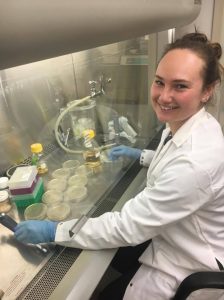My aching arms finally pulled up the last soil core of the day. Dusk had come sooner than expected, and the transparent warming chambers I was working in quickly transformed into ominous black boxes that faded into the dense forest. I pondered the metaphor of soil being a black box, as I knew that soil ecologists were just beginning to uncover the immense diversity of life in soils. I stared down at my hands tinted brown from the soil and thought, well, it’s really more of a brown box after all.
The perplexity of this brown box has captured my attention ever since I began studying extracellular soil enzymes, in warming chambers in undergrad. Now, having moved on to a PhD at Michigan State, I am still perplexed by the complexity of life in soils. My particular interests lie in studying the exchange of information between microbes, whether it is the exchange of extracellular components like enzymes or the exchange of genetic information. Understanding these messages will help scientists to better understand microbe-microbe and microbe-plant interactions that are involved in maintaining functional diversity and global biogeochemical cycles.
To understand how microbes transfer information through the soil matrix, I have to understand how microorganisms function in complex natural environments, which is likely to be drastically different than how bacteria behave in petri dishes in the lab. In a recent trip to Rice University, I worked with the Masiello chemistry lab and the Silberg synthetic biology lab to engineer bacterial strains that allow us to quantify how often bacteria share genes with each other in soil. Synthetic biologists aim to engineer bacteria that can take environmental cues (inputs) and turn them into quantifiable signals (outputs).
 The lab I visited at Rice engineered a system that uses the release of a volatile gas (MeBr) as an output that corresponds with the expression of a methyl halide transferase gene. If a bacterium has the methyl halide transferase gene, it will constantly express this gene and report a gas signal, thus as this gene is transferred to different bacteria, the gas signal gets stronger. Using this simple system that correlates an increase in MeBr gas with an increase in gene transfer, we can explore many new questions about what ecological factors control the exchange of genetic information in complex environments like soil.
The lab I visited at Rice engineered a system that uses the release of a volatile gas (MeBr) as an output that corresponds with the expression of a methyl halide transferase gene. If a bacterium has the methyl halide transferase gene, it will constantly express this gene and report a gas signal, thus as this gene is transferred to different bacteria, the gas signal gets stronger. Using this simple system that correlates an increase in MeBr gas with an increase in gene transfer, we can explore many new questions about what ecological factors control the exchange of genetic information in complex environments like soil.
Our collaborators at Rice have already completed several experiments studying the movement of genetic information in soils collected from the Long Term Ecological Research (LTER) station at KBS. I plan to continue this line of research, most specifically studying how horizontal gene transfer between bacterial species, contributes to functional diversity in soil microbial communities and what factors control the uptake and maintenance of new genes. In soil, there is always free DNA from burst cells available to be picked up by other microorganisms.
It is hypothesized that bacteria pick up free DNA to use as a food resource when they are nutrient starved, but in certain cases this DNA can be integrated into the bacterial genome. Hopefully, I can use the system created by the scientists at Rice to better understand how microbial genomes change over time in the soil matrix. It is likely the mechanisms involved in horizontal gene transfer have greatly impacted the diversity of microbial life on earth today, but to understand how quickly microorganisms might be able to adapt to changing environments, scientists first need to be able to assess the fluidity of microbial genomes.
Moving forward I am hoping to study the transfer of nitrogen fixation genes in soils collected from the Great Lakes Bioenergy Research Center at KBS. Studying nitrogen fixation is an important focus in agricultural research because nitrogen limits productivity in crop systems. To understand the movement of N-fixation genes between bacterial species in soil would be one step toward understanding biological nitrogen fixation in agricultural fields.
The implementation of gas reporter biosensors gives scientists the ability to track the movement of genes in soils, helping to hurdle one of the greatest challenges faced by soil ecologists, which is understanding how bacteria function in the complex and heterogeneous soil environment. Using gas reporters in the soil creates an exciting and unique opportunity to finally see a glimpse inside the brown box of soil!
Click here to read the full publication on volatile gas reporters used in soil.
Heather Kittredge is a second-year Ph.D. student at the W.K. Kellogg Biological Station in the Evans Lab.


A legacy of conservation; a commitment to sustainability.
3700 E. Gull Lake Drive
Hickory Corners, MI 49060
(269) 671-5117
info@kbs.msu.edu